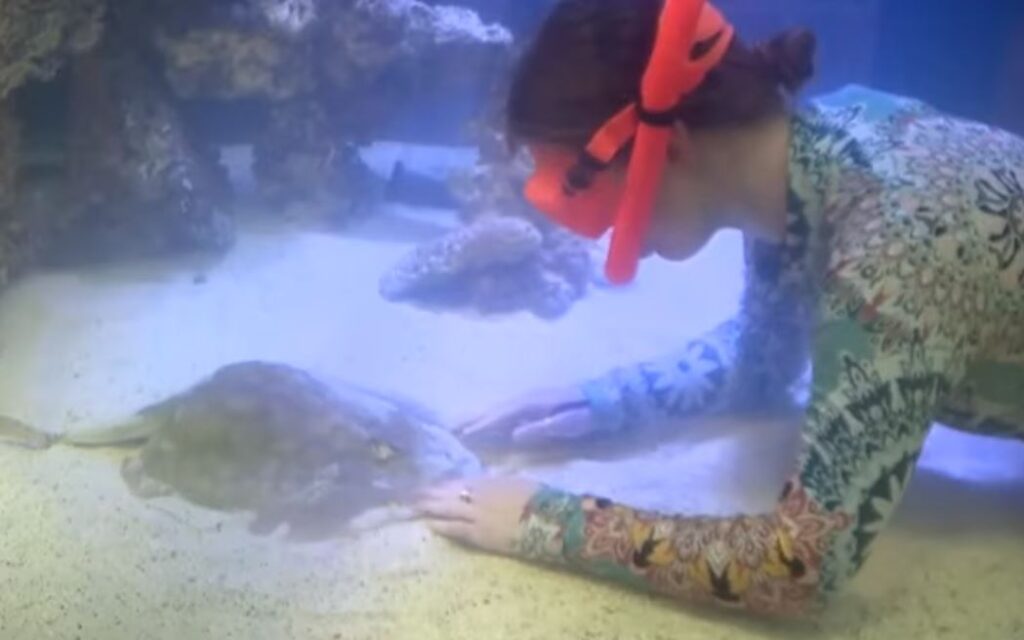
Nestled in the Appalachian Mountains of North Carolina, the Aquarium and Shark Lab on Main Street in downtown Hendersonville is currently unfolding a captivating story.
Charlotte, a sizable rust-colored stingray resembling a serving platter, has defied expectations by conceiving without a male companion, captivating the interest of marine enthusiasts and experts alike.
What You Need To Know
- Unprecedented Stingray Pregnancy:
- Charlotte, a solitary rust-colored stingray in a North Carolina mountain aquarium, defies expectations by becoming pregnant without a male companion, showcasing the marvel of parthenogenesis.
- Educational Focus on Asexual Reproduction:
- Team ECCO’s aquarium turns Charlotte’s pregnancy into a unique lesson on parthenogenesis, highlighting the rare occurrence in round stingrays and emphasizing the importance of marine biology education.
- DNA Testing to Unravel Mystery:
- As Charlotte’s due date approaches, the aquarium plans to conduct DNA testing on the upcoming pups to confirm whether the pregnancy resulted from parthenogenesis or an unexpected interaction with the young male sharks in the tank.
In this mountain aquarium, situated approximately 2,300 miles from her native habitat off the southern California coast, Charlotte has spent the majority of her life.
Remarkably, for at least eight years, she has not shared an aquarium with a male of her species. Nonetheless, Charlotte is now expecting up to four pups, with her due date rapidly approaching.
Parthenogenesis, a form of asexual reproduction where offspring develop from unfertilized eggs, takes center stage in an exhibit organized by the educational nonprofit Team ECCO.
This rare occurrence, observed in various species such as reptiles, invertebrates, fish, and amphibians, is particularly noteworthy in the case of Charlotte, a round stingray.
According to Kady Lyons, a research biologist affiliated with the Georgia Aquarium in Atlanta, Charlotte’s pregnancy marks the only documented instance of round stingrays to her knowledge.
While seemingly unexpected, similar pregnancies have been documented in human care, involving various species like sharks, skates, and rays.
Contrary to initial speculation, Charlotte’s pregnancy is not a result of interactions with the juvenile sharks sharing her aquarium.
Authorities emphasize that these creatures are not engaging in self-cloning. Instead, parthenogenesis occurs when a female’s egg merges with another cell, triggering cellular proliferation and leading to the development of an embryo.
Two plausible hypotheses surround Charlotte’s pregnancy. The first suggests parthenogenesis, wherein Charlotte independently conceived, developing a clone of herself without male intervention.
The second hypothesis proposes an unconventional interspecies interaction, possibly with one of the juvenile male sharks introduced to the aquarium in July, indicated by bite markings observed on Charlotte.
Anticipating Charlotte’s due date within the next two weeks, the aquarium plans DNA analysis upon the arrival of her pups.
This analysis aims to confirm whether Charlotte’s pregnancy resulted from parthenogenesis or a unique interaction with the juvenile male sharks.
Charlotte’s extraordinary pregnancy serves as a testament to nature’s adaptability and resilience.
The mountain aquarium in rural North Carolina becomes a unique stage for a story that transcends traditional reproduction, captivating scientists and marine enthusiasts alike.
Even far from the ocean’s depths, the wonders of the natural world continue to astonish and inspire, as demonstrated by Charlotte’s remarkable journey.
FAQs
- Q: How is it possible for Charlotte the stingray to be pregnant without a male companion? A: Charlotte’s pregnancy is attributed to parthenogenesis, a rare form of asexual reproduction where offspring develop from unfertilized eggs. This phenomenon occurs in certain species, allowing females to reproduce without genetic contribution from a male.
- Q: Could Charlotte have mated with one of the sharks in her tank, as suggested in some reports? A: No, it is impossible for Charlotte to have mated with one of the sharks. While there were speculations about interspecies interactions, experts clarify that these animals are not cloning themselves. Instead, Charlotte’s pregnancy is likely a result of parthenogenesis or the fusion of her egg with another cell.
- Q: What steps are being taken to confirm the cause of Charlotte’s pregnancy? A: After Charlotte gives birth to her pups, the aquarium plans to conduct DNA testing. This testing will help confirm whether the pregnancy resulted from parthenogenesis, a fascinating process where a female’s egg develops into an embryo without fertilization, or if there was a unique interaction with the young male sharks added to the tank.




